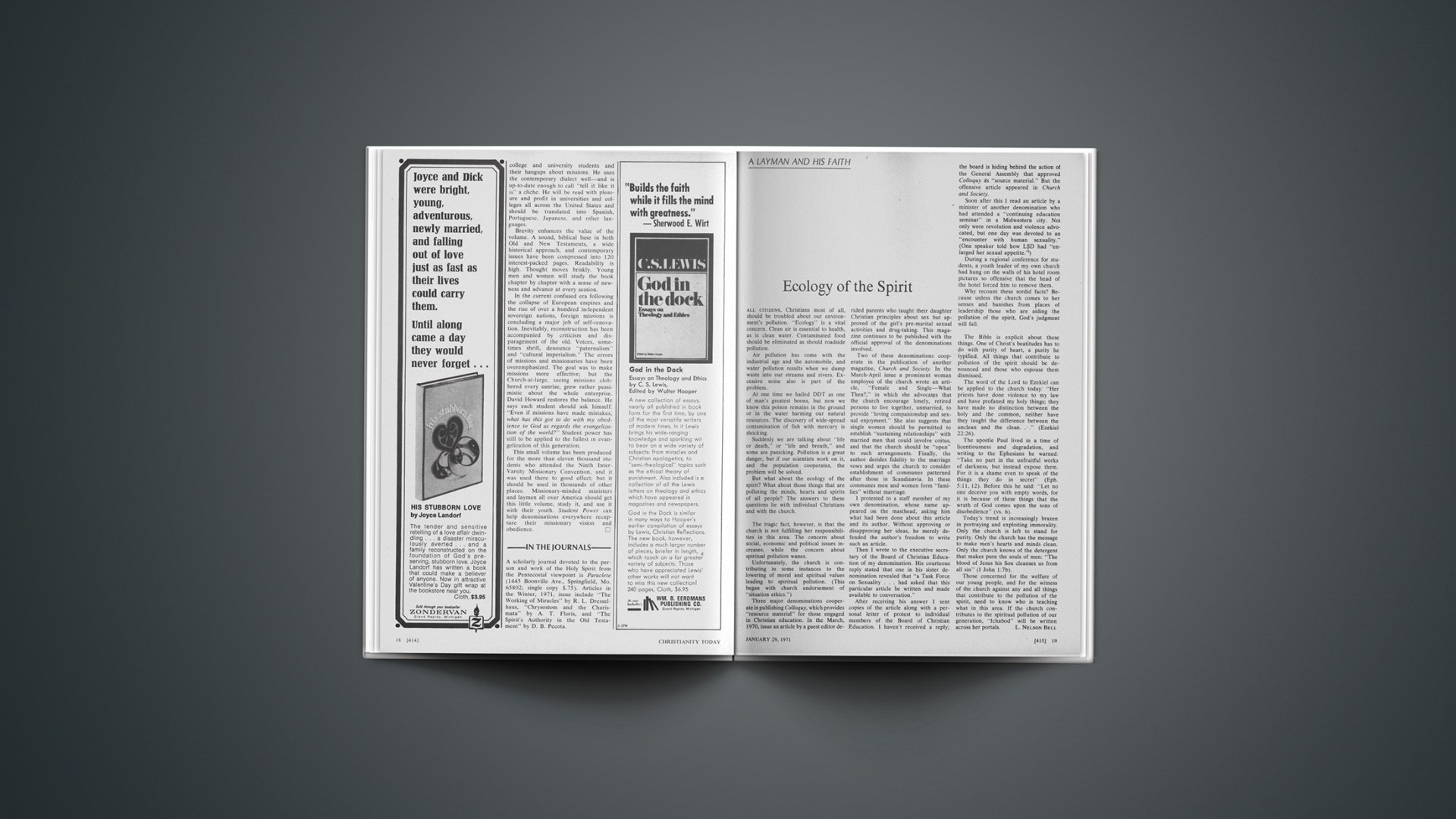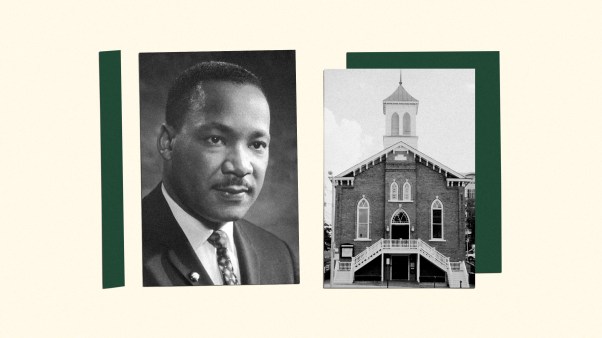All citizens, Christians most of all, should be troubled about our environment’s pollution. “Ecology” is a vital concern. Clean air is essential to health, as is clean water. Contaminated food should be eliminated as should roadside pollution.
Air pollution has come with the industrial age and the automobile, and water pollution results when we dump waste into our streams and rivers. Excessive noise also is part of the problem.
At one time we hailed DDT as one of man’s greatest boons, but now we know this poison remains in the ground or in the water harming our natural resources. The discovery of wide-spread contamination of fish with mercury is shocking.
Suddenly we are talking about “life or death,” or “life and breath,” and some are panicking. Pollution is a great danger, but if our scientists work on it, and the population cooperates, the problem will be solved.
But what about the ecology of the spirit? What about those things that are polluting the minds, hearts and spirits of all people? The answers to these questions lie with individual Christians and with the church.
The tragic fact, however, is that the church is not fulfilling her responsibilities in this area. The concern about social, economic and political issues increases, while the concern about spiritual pollution wanes.
Unfortunately, the church is contributing in some instances to the lowering of moral and spiritual values leading to spiritual pollution. (This began with church endorsement of “situation ethics.”)
Three major denominations cooperate in publishing Colloquy, which provides “resource material” for those engaged in Christian education. In the March, 1970, issue an article by a guest editor derided parents who taught their daughter Christian principles about sex but approved of the girl’s pre-marital sexual activities and drug-taking. This magazine continues to be published with the official approval of the denominations involved.
Two of these denominations cooperate in the publication of another magazine, Church and Society. In the March–April issue a prominent woman employee of the church wrote an article, “Female and Single—What Then?,” in which she advocates that the church encourage lonely, retired persons to live together, unmarried, to provide “loving companionship and sexual enjoyment.” She also suggests that single women should be permitted to establish “sustaining relationships” with married men that could involve coitus, and that the church should be “open” to such arrangements. Finally, the author derides fidelity to the marriage vows and urges the church to consider establishment of communes patterned after those in Scandinavia. In these communes men and women form “families” without marriage.
I protested to a staff member of my own denomination, whose name appeared on the masthead, asking him what had been done about this article and its author. Without approving or disapproving her ideas, he merely defended the author’s freedom to write such an article.
Then I wrote to the executive secretary of the Board of Christian Education of my denomination. His courteous reply stated that one in his sister denomination revealed that “a Task Force on Sexuality … had asked that this particular article be written and made available to conversation.”
After receiving his answer I sent copies of the article along with a personal letter of protest to individual members of the Board of Christian Education. I haven’t received a reply; the board is hiding behind the action of the General Assembly that approved Colloquy as “source material.” But the offensive article appeared in Church and Society.
Soon after this I read an article by a minister of another denomination who had attended a “continuing education seminar” in a Midwestern city. Not only were revolution and violence advocated, but one day was devoted to an “encounter with human sexuality.” (One speaker told how LSD had “enlarged her sexual appetite.”)
During a regional conference for students, a youth leader of my own church had hung on the walls of his hotel room pictures so offensive that the head of the hotel forced him to remove them.
Why recount these sordid facts? Because unless the church comes to her senses and banishes from places of leadership those who are aiding the pollution of the spirit, God’s judgment will fall.
The Bible is explicit about these things. One of Christ’s beatitudes has to do with purity of heart, a purity he typified. All things that contribute to pollution of the spirit should be denounced and those who espouse them dismissed.
The word of the Lord to Ezekiel can be applied to the church today: “Her priests have done violence to my law and have profaned my holy things; they have made no distinction between the holy and the common, neither have they taught the difference between the unclean and the clean …” (Ezekiel 22:26).
The apostle Paul lived in a time of licentiousness and degradation, and writing to the Ephesians he warned: “Take no part in the unfruitful works of darkness, but instead expose them. For it is a shame even to speak of the things they do in secret” (Eph. 5:11, 12). Before this he said: “Let no one deceive you with empty words, for it is because of these things that the wrath of God comes upon the sons of disobedience” (vs. 6).
Today’s trend is increasingly brazen in portraying and exploiting immorality. Only the church is left to stand for purity. Only the church has the message to make men’s hearts and minds clean. Only the church knows of the detergent that makes pure the souls of men: “The blood of Jesus his Son cleanses us from all sin” (1 John 1:7b).
Those concerned for the welfare of our young people, and for the witness of the church against any and all things that contribute to the pollution of the spirit, need to know who is teaching what in this area. If the church contributes to the spiritual pollution of our generation, “Ichabod” will be written across her portals.
EDITORIALS
At the beginning of his public ministry Jesus returned to the synagogue in his boyhood home of Nazareth and read to the congregation from the prophet Isaiah: “The Spirit of the Lord is upon me, because he has anointed me to preach good news to the poor. He has sent me to proclaim release to the captives and recovering of sight to the blind, to set at liberty those who are oppressed, to proclaim the acceptable year of the Lord.” Then Jesus declared: “Today this scripture has been fulfilled in your hearing” (Luke 4:18–21). The mammoth convention of students at Urbana, Illinois, at the close of 1970 (see News, page 29) was essentially a reaffirmation of this startling announcement.
“The Liberator has come!” With these words, evangelist Tom Skinner concluded his address on the second night of the convention, and brought the twelve thousand member audience to its feet with thunderous applause—applause for the speaker, yes, but even more for the Liberator he proclaimed. Among the many titles of Christ, “Liberator” has not been in common use, though “Redeemer,” a term with similar meaning, has been. But as the world gropes about in the anxious seventies, the designation of Christ as Liberator seems especially appropriate. Certainly it was implicit in many of the currents at Urbana.
Christ liberates from aimlessness. Men in rebellion to God have become captive to Satan and hence to the loss or perversion of purpose and meaning in life. Urbana reaffirmed the concern of God that men walk in the ways that he has intended. Only in this way the peace and joy that God intends to accompany life will be found. And the eagerness with which students sought information and counsel from older Christians, as well as from one another, testifies to the desire of many young people to follow God.
Christ liberates men from oppression. Both the victim and the persecutor are (in differing ways) in bondage. Jesus wants to set both free. While still enslaved in body, the Christian can be free in spirit, as has often been demonstrated through the centuries. But in America many white, middle-class Christians are, at least passively, more often identifiable with those who do the oppressing. Many of the speakers at Urbana dealt with this theme at varying lengths. It often goes under the name of “social concern” but it is as much in one’s personal interest, in anticipation of being called to account by God for what he has done and left undone, for all men to be liberated from acting as oppressors.
Christ liberates men from nationalistic and racial bondage. Too often the cause of Christ has been identified with the causes of some nations. The applause of the students at various remarks indicated their approval of the disentangling of the Gospel from Americanism. “Jesus Christ does not wear red, white and blue,” declared Leighton Ford. Christians who, even if unintentionally, imply that Christ is an American must rightly expect the rebuke of the liberated generation. So also with race. Black Christians pay a high price in the disapproval by their unsaved peers for associating with their white brothers. But they do so willingly because Christ has liberated them from having to draw their meaning in life solely from racial solidarity and exclusiveness. White Christians who maintain myths of racial superiority and practices of racial discrimination need the stinging rebuke of those who have, by Christ, been liberated from such worldly bondage as racism.
Christ liberates men from bondage to self. Hell is for those who want to be individuals unrelated to others. Those who are bound for heaven have been set free into a community of brothers and sisters to work and worship and love in every dimension of life, personal and corporate, sacred (for Christians only) and secular (aspects of life in which non-Christians participate as well). Urbana reaffirmed the social implications of the good news that the Liberator has come, while at the same time making it clear that each man must, for himself, accept the Liberator as Saviour and Lord.
Throughout the centuries God has repeatedly used young persons to break forth into new conquests for Christ and to reclaim lost or understressed aspects of the truth which he has revealed. If the enthusiasm, sensitivities, and dedication of those who came to Urbana is representative and persistent, God is indeed bringing new vitality into his people. Such vitality is especially welcome at a time when the world is trying to run its affairs apart from the creator and sustainer of all. May older Christians join in mutual penitence and joy with younger Christians to proclaim through word and deed the good news that the Liberator has come.
A Gulf Spanned At Calvary
Two and half years ago Calvary Chapel, astride the Santa Ana-Costa Mesa boundary in southern California, had a typical cross-section congregation of 150. In 1970 more than 4,000 accepted Christ in the church (see News, page 34). Pastor Charles Smith has baptized more than 2,000 in the Pacific Ocean since May. Thousands of others trace their spiritual heritage to Calvary.
This population explosion was touched off when the church opened a house from which it could reach into the youth drug scene for Christ, and hired a bearded young convert and his bride—Lonnie and Connie Frisbee—to head it up. Soon, in a new sanctuary that seated 300, Calvary had to schedule double, then triple morning services. Recently the church knocked out walls; services are still crowded out.
Most of the thousands of new faces are young “street Christians” who look and talk very much like their peers out in the streets, except that their faces radiate joy and the subject of their conversation is—more often than not—the Lord Jesus Christ.
Calvary is living proof that non-institutional-minded contemporaries and tradition-bound elders can worship together in mutual acceptance and respect. Only five members left because of the youth influx. The cultural gap was bridged, says Smith, during common labor on church building projects: “Businessmen making $25,000 a year and hippies who never held a job saw the love and joy of Christ in each other.”
Smith, who studied at Biola Bible College and the American Baptist seminary at nearby Covina, insists that his preaching is no different from before, and the same order of service is followed as five years ago. His morning sermons are expository, based on ten new Bible chapters assigned to the congregation for study each week. Evening services are question-answer sessions on the same chapters. (Interestingly, the street set prefers to use the King James Version.) Smith is a charismatic, but speaking in tongues and healing are not emphasized in Sunday services.
Why do so many thousands of young people flock to Calvary? Linda Mehler replied that she had been an Episcopalian and a Morman but that Calvary’s people were different: “They weren’t into religion and church; they were into Jesus and the Bible and love.”
A growing number of parents and even grandparents, having seen dramatic changes in the lives of their young, are now attending—and finding Christ and a fellowship of love. Middle-aged Look photographers Jack and Betty Cheetham said they ended a “hate trip” at Calvary (see News, page 34).
The love does not stop at the door. Converts from Calvary are fueling much of the spiritual fire now burning in West Coast states. These activists are proving the song they sign is true; “They’ll know we are Christians by our love.”
Refreshingly, Calvary is pointing the way in a day when so many young Christians tend to write off the institutional churches and when so many older-generation believers, if not downright hostile toward the young, turn their heads and pass by on the other side. We firmly believe that a great spiritual ground swell is building up and may soon flood into the American scene. Christians, young and old, need to open the floodgates to the love of Christ and the power of the Holy Spirit.
Key 73: Bridge Over Troubled Waters
At a time when the nerve for mission seems cut by a lack of confidence within the Church, can evangelicals be used by God to help rekindle the Christian faith? “We can,” says the Reverend Joe Hale, “if pointedly, specifically, and openly we invite other Christians to walk with us, or, perhaps more importantly, we walk with them the road of witness in 1973.”
Hale, director of ecumenical evangelism for the United Methodist Board of Evangelism, was talking about Key 73 during a conference on New Styles in Cooperative Evangelism at the United Methodist Congress on Evangelism in New Orleans this month (see News, page 32). Key 73 is an evangelism movement that seeks to confront every person in North America with the Gospel more fully and forcefully through witness at the individual, congregational, and national levels. Varied programs, determined by the churches that join, will culminate in a year-long effort in 1973.
Hale pointed out that the Key 73 Central Committee, in its meeting last December in St. Louis (see January 1, 1971, issue, page 43), voted to invite Roman Catholic and Orthodox participation in Key 73. Some conservatives in Key 73 have reacted negatively to that decision. Nevertheless, we feel it was wise; there are many in the Catholic and Orthodox communions who are committed to biblical evangelism.
Evangelism and the euaggelion are for the whole Church; the Gospel is not a bone to be growled and fought over by segments of the Body of Christ. The planners of Key 73 wisely drew up broad outlines: the common bond for participants (there are now seventy-three denominations and religious groups involved) is allegiance to Jesus Christ. “Differences in doctrine will be recognized and respected,” a policy statement says. “Varieties in evangelistic expression are expected and will range from traditional forms to vastly new, innovative styles of witness.”
To quote Hale (his enthusiasm is contagious) again: “The concept of Key 73 turns me on.… It is the whole Church speaking.… It may generate a movement of Christian advance that will extend like a tidal wave around the entire globe.” We hope and pray that when our brethren in the Roman Catholic and Orthodox churches receive their invitations, they will respond with wholehearted support and participation.
Christian Endeavor At 90
This magazine reported last year that the once-great Christian Endeavor youth movement was showing new signs of life after a period of decline, and this year CE Week (January 31-February 7) is getting more attention in local churches than it has had in a long time. The Rev. Charles W. Barner, general secretary of the International Society of Christian Endeavor, says requests for organizing kits have hit a thirty-year high. Thus CE enthusiasts mark the movement’s ninetieth anniversary February 2 on an optimistic note.
New interest in Christian Endeavor comes at a time when church youth programming materials produced by many large denominations reflect a secularizing trend that is often stoutly resisted at the grass roots. Planners of all theological stripes are somewhat at a loss as to how to adapt to today’s youthful turbulence. The rally idea used successfully by Youth for Christ after World War II now seems to have limited appeal. The Bible-club approach still has momentum, but innovations are needed.
Development of effective new curriculum materials is probably the big challenge and opportunity facing CE—and, for that matter, all other youth programmers. We have the most literate crop of young people the world has ever produced, and unless their minds are creatively engaged with the cause of the Gospel, alien ideologies will wrest their attention. CE can best honor its late founder, the Rev. Francis E. Clark of Williston Congregational Church in Portland, Maine, by applying itself to the task with renewed intensity.
Though officially creedless throughout its history, CE in its primary thrust has been unabashedly evangelical. It currently has impressive representation in the inner city as well as in suburban and rural areas. These factors point to a bright future if CE leaders bring more young people into their decision-making processes and develop materials that are relevant to the crucial needs of these days.
Financing Murder
One of the most apparent manifestations of moral rot in America is the recent liberalization of state laws on abortion (see also Current Religious Thought, page 38). Human life is now being exterminated at a rate probably not equaled in any war this country has ever fought. Authoritative estimates indicate that 250,000 legal abortions are performed in the United States each year. Precious few voices are raised in protest against this mass homicide of unrestricted abortion on simple demand. And at a time when Christians are becoming involved, on all levels, in political and social efforts, to ignore the question of abortion is a serious mistake.
Compounding the evil is the fact that government (through Medicaid) and insurance companies are defraying the costs of an increasing number of abortions. Society, instead of protecting the helpless unborn, is financing their demise. Never mind that millions of people regard abortion as murder. Their tax dollars and insurance premiums are appropriated along with the rest.
God does not overlook such evil. Let it be no great surprise when America is subjected to severe judgment. The guilt belongs not only to legislators and insurance executives but also to rank-and-file citizens who fail to speak against this wickedness.
Bang Bang
These days, clothes talk. Perhaps the loudest accessory to hit the fashion bull’s-eye recently is a three-pound belt of brass cartridges linked together and fastened by several dummy bullets. What the bullet belt aims to communicate is not entirely clear. Some charge that it says, “Bang, you’re dead.” Others claim its message is, “Better belt it than blast it.”
At least, say those fired up about it, the bullet belt is loaded with fun. Perhaps, but their good humor shoots down good taste. The belt may even be a plowshare of sorts—a macabre sort that retains sword-like characteristics. That it belts a potential big bang even the United States Treasury Department warns: converting cartridges into live ammunition is not only hazardous to one’s health but also illegal without a license.
There must be a more telling accessory for the fun-loving, fashion-conscious peacemaker. A Bible belt maybe? At least that’s a belt with something to say.
Neighborhood Pilgrims
Beginning in February, more weekend pilgrimages will be possible through the new holiday schedules. Although boredom already threatens a generation frantic with efforts to keep moving, leisure time continues to increase, and many advocate a four-day work week. In this mobile age, pilgrims flock to beaches and ski resorts, parks and camps. The variety of weekend pilgrims rivals Chaucer’s famous congregation (many of whom journeyed to Canterbury for diversion, and not because of relitious fervor).
Traveling was popular long before Chaucer made it prominent. Today people seem to consider it the only way to spend holidays. Suggestions to relax, putter, or read are disregarded. Reading and meditating seem rather incompatible with what we call the pace of modern living. There is no time for such things, people insist. Well, there is—particularly on a three-day weekend at home. Read about those pilgrims to Canterbury. Better still, take another look at Acts and learn about a famous pilgrim for God—Paul. And after reading about Paul and his fellow travelers, discover what you, in your own neighborhood, can do for God and your fellow pilgrims.
San Francisco: Sodom Revisited
Last month San Francisco Examiner publisher Charles Gould and his editors decided to stop abetting “the dispensers of depraved ‘entertainment’ ” by bringing advertisement practices into closer alignment with what the newspaper’s editorial pages preached. “We do not seek to impose the Puritan ethic on the community in general or our readers in particular,” they announced editorially. “However, we can no longer permit our advertising columns to be exploited by the panderers of moral pollution.… We should have thrown this ugliness out … long ago. We are sorry we delayed. It is out now. And it will stay out.”
We applaud their decision. They said that for years they had urged movie makers and night club operators to “upgrade and improve” their ads. But this approach, they correctly observed, “merely laundered the advertising … and thus tended to hide the slime of the shows being presented.” The “slime” they cited: movie houses showing women engaged in sex acts with animals; films showing groups of perverts performing vile acts that demoralize homosexuals who seek a higher way of life; films showing prostitutes performing sordid acts that defy description; films showing young girls being beaten, raped, and defiled in sexual aberrations practiced “only by those with maniacal or criminal minds.”
They could have mentioned more. The topless clubs on Broadway feature not only nudity but also simulated sex acts. Shops that openly sell hard-core pornography flourish throughout the city. Nearly one hundred bars, nightclubs, and theaters cater to the homosexual population, estimated to be over 50,000 on weekends. These and other conditions are giving San Francisco an international reputation as the Sodom of our day.
The Examiner’s editors received no guidance from the courts, whose permissiveness has opened a sewer outfall into the very lifestream of society. The Supreme Court decreed, for example, that “community standards” should determine what is and what is not obscene. But, declared the editors: “After witnessing the results of this decision, we are now convinced that community standards do not determine what is pornography. Quite the contrary. We believe the results in San Francisco are proof positive that proliferating pornography creates debased community standards.… We are denouncing the sexual depravity on film and stage that can—and does—breed moral pollution and social degeneracy.”
The depressing situation calls for action and prayer. The city’s Christians should firmly and vocally support the Examiner’s position in the face of threatened lawsuits. It is time for the courts to re-draw the boundaries between liberty and license, this time favoring the greater welfare of society rather than the greed and corrupt nature of the moral subversives. And citizens, without flagging, should prod both government and the filth merchants. We commend the hundreds of young Christians who picketed in protest on Broadway a few months ago; “business” almost came screeching to a halt. The youthful evangelicals did more than protest. They reached for the ultimate solution—changed lives. Dozens of persons received Christ during witness encounters on Broadway.
The Christian effort is admittedly only a drop in the proverbial bucket. More than 450,000 of the city’s 750,000 population claim no religious affiliation whatsoever. In some neighborhoods of 10,000 or more, no churches exist. And the moral spiral speeds downward with little restraint.
We challenge the Christians in and around San Francisco to get involved in the spiritual struggle for the soul of that city. God said he would spare Sodom if some righteous people could be found.
Getting Things From God
One of the purposes of prayer is for Christians to get things from God. He owns the cattle on a thousand hills and he will supply the needs of his children if they petition him to do so. Getting things from God, of course, is not all there is to prayer. Adoration, thanksgiving, and confession too are a part of praying. Here, however, we want to consider the question of getting specific answers to prayer for personal needs, loved ones, friends, and others.
With three words—ask, seek, knock—Jesus laid down the principles of getting things from God. These words have important differences in meaning; yet they are related.
To ask means we should come to God telling him what we want. James says that “you have not because you ask not.” Stated another way, “he who does not ask does not get.” God has graciously ordained the method by which we can expect to get things from him—we must ask!
Asking must be complemented by seeking. Seeking is the human side of this prayer relationship with God. At times there is nothing that Christians can do except wait on him. But most of the time action is necessary. The man who asks God for a job should go out and look for one. The farmer who prays for crops should plow, plant, and cultivate. Asking God does not remove man’s responsibility for doing what he can to bring about the desired result. A story is told about Dwight L. Moody traveling on an ocean liner when a fire broke out. A dear brother in Christ suggested that they go to their cabins and pray. Mr. Moody said, “You pray; I’ll pass the water buckets.” There is a time to pray and a time to work.
Jesus also said we are to knock. This means twofold perseverance; we are not to stop asking until we have received and we are not to stop seeking until we have found. It is always too soon to quit. We are not to become fainthearted and we must continue the pursuit until the answer comes.
Asking, seeking, and knocking are God’s orders for those who expect him to give.










